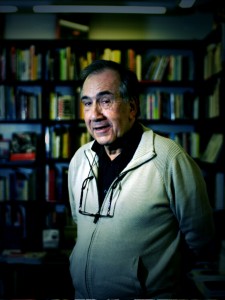Literary Portrait Photography: Capturing Spanish Poet Joan Margarit in Barcelona

Photographing a Celebrated Bilingual Catalan Poet
This portrait session marked my first interview assignment for Metropolitan Magazine, featuring Joan Margarit, one of Spain’s most distinguished literary figures. Margarit has earned widespread recognition for his remarkable poetry written in both Spanish and Catalan languages, making him a cultural bridge in Barcelona’s diverse literary landscape. His work explores themes of loss, memory, and the human experience with profound sensitivity that has resonated with readers across Spain and internationally.
The photography opportunity arose during a book reading event at a local Barcelona bookstore, where Margarit was presenting his latest collection to an appreciative audience. Literary events provide unique portrait opportunities, allowing photographers to capture subjects in their natural element while engaging with their craft.
Overcoming Challenges in Event Portrait Photography
As often happens with on-location portrait photography, we encountered several unexpected challenges during the session. Time constraints presented the primary obstacle—a common issue when photographing public figures with busy schedules. Additionally, the bookstore manager had not been properly informed about our planned photography session, creating tension as we attempted to set up equipment in the limited space.
Lighting Techniques for Indoor Portrait Photography
Despite these complications, Margarit himself proved exceptionally cooperative, allowing us to create compelling portraits that captured his character. The image featured here reveals a captivating twinkle in his eye—a moment of genuine expression that elevates the portrait beyond a mere documentation of appearance.
The lighting setup involved positioning a strobe camera-left, creating dimensional light that highlighted Margarit’s expressive features. Having the magazine’s designer, David, on location proved invaluable for this technical arrangement. Human light assistants offer significant advantages over static light stands—they can hold equipment at precise angles that would be difficult to achieve with conventional stands, adapt quickly to changing conditions, and maneuver in tight spaces.
This collaborative approach to portrait photography not only produced superior results but also provided an unexpected benefit: while I focused on equipment breakdown and making a discreet exit, David could manage the increasingly impatient bookstore manager. This division of responsibilities exemplifies how teamwork can overcome the logistical challenges often encountered in editorial portrait photography.
